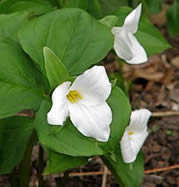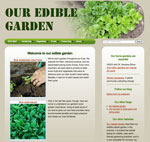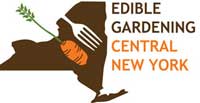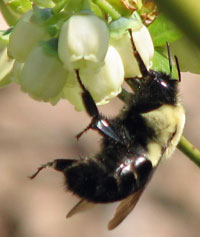| iMapInvasives Training Tues. May 15 at SUNY-ESF |
 | Garlic mustard
|
| iMapInvasives is an online mapping tool that supports efforts to protect New York State from invasive species.
Learn about the program and become trained to contribute data by attending an iMapInvasives training session.
The New York Natural Heritage Program and the Finger Lakes Partnership for Regional Invasives Species Management will be offering a free iMapInvasives
Training on Tuesday May 15th from 9:30 - 12:00 at SUNY-ESF in Syracuse.
The training will offer options from basic (observation) to advanced (survey, assessment and treatment) data entry.
All interested groups, from land managers to the general public, are encouraged to attend and help keep the NYS map up-to-date and accurate.
Register here or
find other sites and dates for the free training.
|
Baltimore Woods Plant Sale and Programs
|
 | Trillium
(Trillium grandiflorum) |
| Plant Sale - includes native plants!
Members only: Fri. May 18 4-7 pm
Public sale: Sat. May 19, 9 am to 2 pm
Preview the list of native plants available and get more details about the sale. Both red and white trillium included!
Weekend Wildflower Walks Sat/Sun May 12/13.
Join caretaker Audrey Loewer for a pleasant walk through the wonders of spring. Donations appreciated.
Signs of Spring
Tues, May 8, 10:30-11:30 am. Join a Naturalist for a walk along Baltimore Brook. Fee.
For info and to register, call the Woods at 673-1350.
|
| Be on the map: YardMap | 
| YardMap is an interactive citizen science project developed by Cornell's Lab of Ornithology. It's based on Google maps and allows you to draw maps of yards, parks and community gardens.
You share valuable habitat data with Lab of Ornithology scientists, connect with other people around the country, and learn about your ability to impact birds.
A video on the home page shows you how to do it.
Habitat gardeners have a lot to contribute to understanding how yards can help birds.
Sign up on the YardMap website.
|
Learn by doing! Help maintain the zoo garden
|
 | | The zoo's habitat garden |
|
One of the best ways to learn anything is work alongside experts and other learners like yourself. A great way to learn more about habitat gardening and native plants is to volunteer to help maintain the habitat garden at the zoo. Contact Kate Woodle if you're interested.
|
| Our Habitat Garden |  |
Visit Our Habitat Garden website for information on providing habitat, earth-friendly gardening practices, plants, and various creatures here in Central New York.
|
|
Join HGCNY!
|  |
Becoming an official member of HGCNY is easy: just join Wild Ones! When you're a Wild Ones member, you're automatically an official member of HGCNY. |
| HGCNY on Facebook |
As as more of us participate on our Facebook page, this will become a useful resource for asking (and answering!) local HGCNYers' questions about habitat gardening. Join in what can become a very useful conversation about habitat gardening in Central New York.
|
Our Edible Garden - Recently updated with more resources!
|  | | Visit OurEdibleGarden.org to see an example of a Central New York edible garden, the perfect companion to your habitat garden. |
| Interested in Edible Gardening? | 
|
If you'd like to get information on Edible Gardening CNY, just email John to find out about edible gardening tours and programs. |
|
Greetings!
We've had a great series of programs from September through April, and we're planning another series of equally informative programs starting next September.
Time for summer tours
 | | Explore a habitat garden! |
Now it's time for our summer Show Me, Help Me tours. This year, we've created an application for people who would like to offer their yards for the tour. As the name "Show Me, Help Me" implies, these aren't necessarily finished, formal gardens, but are examples of habitat gardens from relatively new to fairly mature gardens. And every gardener has things to "show" that are working well, and areas where they'd like "help" with some problem-solving suggestions.
If you would like to offer your yard for a tour, please fill out this application and email it back to Linda Rossiter or Randi Starmer. Thanks!
Learn more about habitat gardening!
 | | White crowned sparrow |
I'll be giving two more presentations at Liverpool Library from 6:30 to 8:00 pm. Free and open to the public. Come and bring a friend!
Tues. May 8: Creating a bird-friendly yard
Tues. May 15: Designing an earth-friendly yard
~ Janet Allen
|
|
|
Butterfly migration
 | | Red admiral |
It's hard to miss the continuing migration of red admiral and question mark butterflies coming through CNY the last week or so.
Red admirals are seasonally migratory, and the size of the population varies from year to year. They overwinter mainly in the south. They lay their eggs on primarily on nettles.
Learn more about red admirals at Butterflies and Moths of North America or at The Vanessa Migration Project (Iowa State Univ.), a research project.
Not baby monarchs! Even though they're orange and black and they're smaller than the monarch we see in summer, the butterflies we've been spotting recently are not baby monarchs. When a monarch emerges from its chrysalis, it's fully grown (although it takes a little time for its wings to fill out).
So what is a baby monarch? A caterpillar! |
|
Native plant garden spurs children's interest in science
 | | Bugs are interesting! |
From a Los Angeles Times article by Louis Sahagun
Native flora planted at an urban L.A. school drew not only insects and birds, but also increased students' science test scores ... 6-fold!
In partnership with Los Angeles Audubon, the school applied for and won the "schoolyard habitat" and partner's grants from the U.S. Fish and Wildlife Service.
The children are studying the dynamics governing the behavior of birds and the ecological systems that support them. They're also compiling an illustrated survey of every species they've found in their urban bird sanctuary. In other words, they're doing science, not just reading about it in a textbook!
You can connect children with nature in your habitat garden
The classic book Sharing Nature with Children by Joseph Cornell is now available in a 20th anniversary edition. Lots of nature games.
Read more about the Children and Nature movement from Richard Louv, author of Last Child in the Woods.
Our Habitat Garden resources: Read more about children in the habitat garden and about resources for schools.
|
|
"But where do I find native plants?"
 | |
(Click image to download)
|
To help you find native plants in CNY, we've compiled a list of plants offered by several local nurseries. REMEMBER, nurseries can sell out of any particular plant, so it's a good idea to call before setting out on your shopping trip! DOWNLOAD: This guide is available online as a free .pdf download. |
|
Pesticides at home
 Until recently, researchers have focused on the connection between agricultural pesticides and bee die-offs. Until recently, researchers have focused on the connection between agricultural pesticides and bee die-offs.
Neonicotinoid pesticides are present not only in agricultural products, but also in common household products. And homeowners, nurseries, and urban landscapers may use them in larger quantities--up to 40 times greater--than used in agriculture.
Systemic pesticides spread throughout the plant, including the nectar and pollen. It isn't yet known whether they accumulate in a plant from year to year.
Read the article on "Controversial pesticide linked to bee collapse" on the Xerces website or on
Wired Science.
Learn more from Our Habitat Garden about a having a pesticide-free yard. |
|
Bat houses and more
 People at our last program expressed an interest in installing bat houses. People at our last program expressed an interest in installing bat houses.
Bat Conservation International (BCI) has information about installing bat houses, and at the bottom of that webpage, there are downloadable articles on
* Criteria for successful bat houses
and
* Tips for attracting bats.
BCI also has information on:
* Bats in buildings and how to safely remove them
and
* Do-it-yourself bat exclusion techniques
They even have a video on how to safely and humanely remove a bat from your house. |
|
On children and nature
 From Sara Stein Noah's Garden: From Sara Stein Noah's Garden:
I'm lucky to have spent my childhood summers among woods, streams, meadows, and marshes, but most suburbanites have never searched for frogs' eggs, caught fireflies in a jar, or peeked into a grassy nest of adorable baby mice.
As the years pass, fewer and fewer people will long for the call of bullfrogs.
Today's children, growing up on lawns and pavements, will not even have nostalgia to guide them, and soon the animals will be not only missing but forgotten.
From Richard Louv, Children and Nature Movement:
I told the audience how, when I was a boy, I felt such an intense sense of ownership of the woods near my home that I pulled out scores of developers' survey stakes in a vain attempt to keep the earthmovers at bay.
After the speech, a rancher stood up. He was wearing scuffed boots. His aged jeans had never seen acid wash, only dirt and rock. His face was sunburned and creased. His drooping moustache was white, and he wore thick eyeglasses with heavy plastic frames, stained with sweat. "You know that story you told about pulling up stakes?" he said. "I did that when I was a boy too."
The crowd laughed. I laughed. And then the man began to cry. Despite his embarrassment, he continued to speak, describing the source of his sudden grief--that he might belong to one of the last generations of Americans to feel that sense of ownership of land and nature. |
|
|
|
|